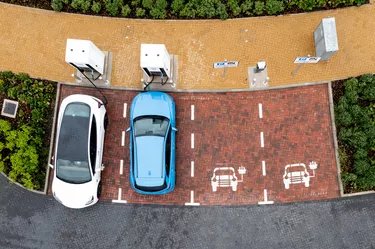
California is the most populous state with 39,185,000 in 2022. Their sheer population numbers influence what happens in the rest of the U.S. Recently, the California Air Resources Board voted to ban the sale of new gas-powered cars in favor of electric vehicles. Clean air in smog-ridden cities like Los Angeles is one objective.
This is the most significant shift away from gas cars in the U.S. How will this affect Californians who have a gas-powered car? And how will California's new rule affect those in other states who own gas-powered cars? This new vehicle rule could have repercussions across the U.S.
Video of the Day
Video of the Day
California Air Resources Board Ban
These new vehicle mandates have the goal of 100 percent zero-emission vehicles sales by 2035. After that, California plans to phase out gas-powered cars over the next 13 years.
They will require a minimum of 35 percent of electric vehicles sales by 2026. The auto market will then need to increase the number of electric vehicles by 6 to 8 percent annually until 2035. Plug-in hybrids will still be able to be sold. The plug-in hybrids can make up 20 percent of new car sales. But fully electric cars are the priority.
In 2035, to decrease greenhouse gas emissions, the California Air Resources Board will require that all new cars sold be zero-emission vehicles. The goal is to positively affect climate change.
These mandates only affect new cars sold. California citizens will still be able to drive gas-powered cars and purchase used gas-powered cars.
Alliance for Automotive Innovation Comments
The recent passage of the Inflation Reduction Act stressed zero-emission vehicles. The California Air Resources Board decision dovetailed on this act.
Alliance for Automotive Innovators CEO John Bozzella, said that the auto industry had already invested $100 billion in electric vehicles.
In 2035, to decrease greenhouse gas emissions, the California Air Resources Board will require that all new cars sold be zero-emission vehicles.
Automakers Selling Electric Vehicles
Three automakers that have jumped on board manufacturing clean cars include Toyota, General Motors and Ford. They manufacture SUVs, passenger vehicles and trucks.
Toyota supplies electric cars and plug-in hybrids. Two of their plug-in hybrids include the RAV4 Hybrid and the Highlander Hybrid. And of course, they still have one of the plug-in hybrids that started it all: the Prius. So their electric cars are similar brands to their gas-powered vehicles.
General Motors has several electric vehicles, but two stand out. The Bolt is one of the passenger vehicles that has been around for years, and the newest electric Blazer is a sleek new version of tried-and-true gas-powered vehicles.
Ford also has EVs and plug-in hybrids. One of their plug-in hybrids is the Escape SE. Ford also has the Mustang Mach-E for those sports car enthusiasts.
Semiconductor Shortage Hampering Auto Industry
The auto industry might be held back by the semiconductor shortage due to the stifled supply chain. Gas-powered cars have roughly 1,000 chips in them. But electric vehicles are built with approximately 2,000 chips.
Climate change might dictate the reduction of the sale of new gas-powered cars, but a semiconductor shortage might stop production in its tracks. This could inhibit Californians from purchasing new electric cars.
California Charging Stations
California has 14,646 charging stations. That's more than any other state. New York is second with 3,216. But with roughly over 25 million licensed drivers, that probably won't be enough to power even half of those electric vehicles. This could hamper the California Air Resources Board mandates.
California is also the third largest state in area in the U.S., with 155,973 square miles. Just over 14,000 charging stations may not be enough to cover the state's large area.
Electric vehicles are restricted as to how long they can go between charging stations. According to Car and Driver, the electric vehicle that can go the farthest is the Lucid. Based in California, the Lucid can go up to 471 miles on a charge, according to an EPA estimate. But it weighs in at the hefty price of $170,500. Most Americans can't afford that price tag.
One of the lower-priced electric cars is the Mini Cooper SE. The cost is $30,750, but the EPA estimates its range between charging stations as 114 miles.
These are zero-emissions cars, but they both may be out of middle-class Americans' budgets. And they may not be able to go the mile in the large California square mileage.
Inflation Reduction Act Advancing EVs
In the 2022 Inflation Reduction Act, the government extended the tax credit on electric vehicles. The tax credit remains at $7,500 for electric new car sales.
The act also established loans for manufacturing facilities of "either a low amount or no amount of greenhouse gas emissions." Loans were also enacted for the domestic production of plug-in hybrids.
- U.S. Department of Energy: Alternative Fuels Data Center
- Congress: H.R. 5376-Infation Reduction Act of 2022
- Auto Innovate: Auto Innovators Statement on Enactment of Inflation Reduction Act
- California Air Service Board: The California Air Service Board
- NPR: California is Poised to Phase Out Sales of New Gas-powered Cars
- Forbes: California Approves Ban on Gas-Powered Cars by
- Department of Finance California: Slowing State Population Decline Puts Latest Population at 39,185,000
- Government Tech: Which State Has the Most Charger Per Electric Vehicle
- Department of Energy: Alternative Fuels Data Center
- Scientific American: Chip Shortage Threatens Biden’s Electric Vehicl Plans
- Toyota: Electric Cars
- General Motors: Electric Cars
- Federal Highway Administration: Highway Statistics Series
- State Symbols USA: Size of States
- Car and Driver: Longest Range Electric Cars Ranked
- Ford: Electric Vehicles